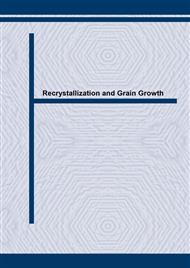p.641
p.647
p.653
p.659
p.665
p.671
p.677
p.683
p.689
Monte Carlo Modelling of Recrystallization Process in Cold Rolled IF-Ti Steel
Abstract:
Recently, some authors have used the Monte Carlo modelling using complete set of experimental data to get a better correlation between experimental observations and calculations concerning recrystallization process [1, 2]. Simulations using Monte Carlo technique have been performed these last years for IF-Ti steels in order to predict the microstructure and the texture evolution after high reduction amounts by cold rolling [3, 4]. On the contrary, in the present work, this evolution is simulated in an IF-Ti steel cold rolled after low deformation amount (reduction amount R = 40 %). Microstructure is characterized by Electron Back-Scattered Diffraction and introduced in the model. The quality index of the Kikuchi patterns (EBSD data) is used to qualitatively evaluate the stored energy for each grain. Different hypothesis of nucleation mechanisms have been introduced into the model. It has been shown that the better recrystallization texture correlation between experiment and simulation is obtained by taking into account the nucleation in the low stored energy sites and highly misorientation regions. Finally a simulation issue was compared with EBSD and TEM experimental results: microstructure, recrystallization kinetics and Avrami coefficients values.
Info:
Periodical:
Pages:
665-670
Citation:
Online since:
October 2004
Price:
Сopyright:
© 2004 Trans Tech Publications Ltd. All Rights Reserved
Share:
Citation:


